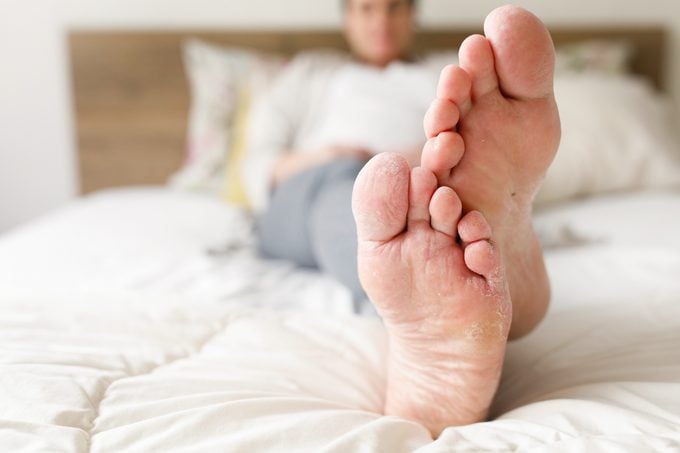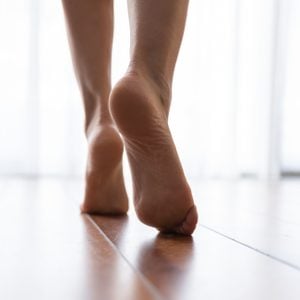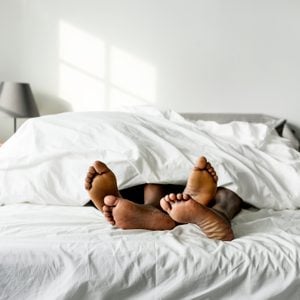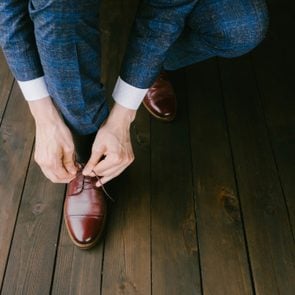Athlete’s Foot: 10 Things Foot Doctors Need You to Know
Updated: Apr. 27, 2021
Athlete's foot is an aggravating and highly contagious fungal infection of the foot. Here's what you need to know to get rid of it.
Our editors and experts handpick every product we feature. We may earn a commission from your purchases.
On This Page
How you get athlete’s foot
Doctors call it tinea pedia, but we know it as athlete’s foot, a skin condition that causes unbearable burning and itching on the feet. It’s caused by a fungus that naturally lives in the environment and on the skin. But that doesn’t mean you’ll automatically get it.
This type of fungus attacks the feet because it thrives in dark, moist, and warm areas—like the inside of your shoes and around swimming pools, locker rooms, and showers. The infection is common among athletes whose feet were regularly in these places, so the name athlete’s foot stuck.
But foot fungus is nothing you want to stick around. Thankfully, the condition is treatable. Here is what you should know about the symptoms, treatments and home remedies, and precautions you should take.
Athlete’s foot is highly contagious
Before we dive into the symptoms and treatments, it’s important to note that athlete’s foot highly contagious. It can spread to other parts of your body and to other people.
“Athlete’s foot can spread to the hand from scratching the rashy, itchy skin of your feet,” says Courtney Grimsrud, an orthopedic surgeon with UCHealth Foot and Ankle Center-Central Park in Denver. “It can also spread to the toe or fingernails. It can even spread to your groin as the fungus travels up the body from hands, clothing, or wet towels.”
Keep reading for ways to stop the spread.
Symptoms
It’s true athlete’s foot can cause relentless itching and burning, but that’s not the case for everyone.
“I’ve had some patients who didn’t even know they had athlete’s foot, and I’ve had some that were very bothered by it,” says Joseph Zahn, MD, a dermatologist and assistant professor of dermatology at the George Washington University Medical Faculty Associates, Washington, D.C.
For most people, athlete’s foot is a persistent infection that usually affects the toes but sometimes impacts the whole foot.
The signs of athlete’s feet differ depending on the type and severity. One or more of the following symptoms might be present:
- Burning and itching initially just between the toes, but this may spread to other parts of the feet if the infection grows
- Dry, scaly, or peeling skin
- Slight odor
- Thicker skin on the bottom or heel of the foot
- Swelling or inflammation
- Soreness
- Blisters or ulcerations in between toes and on the foot
Types of athlete’s foot
Athlete’s foot is often broken down into three types:
Toe web infection: “The fungus grows and affects the skin between the toes, typically between the fourth and fifth toes,” says Dr. Zahn. Itching, burning, and a slight odor are typical in this most common type of athlete’s foot. As the fungus progresses, the skin between the toes becomes scaly and peels and cracks.
Moccasin type infection: This type is named for the area of the foot it affects, not because it’s tied to wearing moccasins. The skin on the bottom and sides of the foot is affected, causing dry, itchy, burning, or scaly skin. As the fungus advances, the skin becomes thicker and cracks and peels. Sometimes a toenail fungus develops.
Vesicular type infection: “The patient gets an outbreak of small, fluid-filled blisters anywhere on the foot but usually on the bottom,” explains Dr. Zahn. Open blisters may pave the way for bacterial infections to develop.

Treating athlete’s foot
You can treat athlete’s foot at home, but more stubborn cases may need a doctor’s attention. Treatment may relieve some of the irritating symptoms, but wiping out the fungus completely may take longer, depending on the individual and the type of athlete’s foot.
“It’s not usually quick, taking on average around a month to completely eradicate the infection in most circumstances,” says Dr. Zahn. “It depends a lot on the individual, how diligent they are with treatment, etc.”
Over-the-counter remedies
There are many antifungal remedies to treat athlete’s foot, so how do you know which one will work?
Dr. Grimsrud has some tips: Try medications that end in “zole,” like miconazole (Desenex) and clotrimazole (Lotrimin). They’re antifungal agents. You can also use medications ending in “fine,” such as terbinafine (Lamisil AT) and butenafine (Lotrimin Ultra).
Most antifungal medicines come in powders, creams, and sprays. Choose whichever method you prefer.
If you’re not sure which to buy, ask your pharmacist or doctor which antifungal might be right for you.
Whatever remedy you pick, Dr. Grimsrud says it’s vital to stick to one medicine at a time. And even if your symptoms disappear, finish the medication as recommended. The absence of symptoms doesn’t necessarily mean the fungus is dead.
Treatment for blisters
For blisters, which as common with vesicular type infection, try soaking feet in a Burow’s solution (Domeboro) three times daily. It’ll help dry up blisters and ease itching and burning.
Home remedies for athlete’s foot
If there’s a way to cure ailments by grabbing something from the pantry, we’re all for it. Before we dive into some home remedies, it’s important to mention a couple of caveats.
First, if you have diabetes and have itching, burning, redness, or swelling, or if you discover white, yellow, or black marks or an ingrown toenail, you should forgo these remedies and see your doctor first.
Second, athlete’s foot is contagious and stubborn. Your feet may feel and look better, but that doesn’t mean the fungus is completely gone. The fungus could still be alive and still spread.
There are no guarantees the following athlete’s foot home remedies permanently kill fungi. But in the very least, you’ll pamper your feet and may get some soothing relief.
Vinegar foot bath
There’s a lot of online chatter about vinegar as an athlete’s foot treatment. Vinegar has been a go-to for a host of medicinal purposes for centuries, but science is lacking when it comes to whether or not it can cure athlete’s foot.
There’s not a lot of proof this treatment will do you any good, but if you still want to give it a go, know how to properly mix up the foot bath. Rule No. 1: mix the vinegar with water.
Typically, the formula is one part vinegar to two parts warm water. Soak for 10 to 15 minutes. Be sure to thoroughly dry your feet after, and don’t forget to get in between those toes.
Tea tree oil
Some people try essential oils for athlete’s foot. You might already know that tea tree oil is a popular natural remedy for acne, insect bites, dandruff, psoriasis, and more. As an antifungal and antibacterial agent, tea tree oil may help treat athlete’s foot.
Research showed improvement of athlete’s foot in participants who used either 50 percent tea tree oil with ethanol (a type of simple alcohol) and polyethylene glycol (an additive used in pharmaceuticals) or a lower dose of 25 percent tea tree oil. Surprisingly, the people who used 50 percent tea tree oil didn’t see greater improvement over those who used just 25 percent tea tree oil.
Dermatitis (skin irritation) occurred in some patients, so the study authors recommend 25 percent tea tree oil. As with all essential oils, be sure to mix with a fatty carrier oil, such as olive or jojoba oil, for a concentration of 25 percent tea tree oil. Stop using it if your skin becomes irritated or red.
Hydrogen peroxide
Some people try hydrogen peroxide for athlete’s foot. Hydrogen peroxide is an antiseptic used for the efficient control of various bacteria on the surface of the skin, which could cause an infection.
Don’t pour it directly onto your feet. Add one pint of hydrogen peroxide to a gallon of warm water and soak for 10 to 20 minutes. Rinse your feet and dry thoroughly (don’t forget between the toes!).
Baking soda
Like vinegar, baking soda is an age-old remedy for a host of ailments. In a study, lab tests revealed baking soda is effective at suppressing the growth of fungus.
To give it a try, fill a basin with warm water and add a half cup of baking soda. Soak for 15 to 20 minutes, and dry your feet completely afterward.
Dos and don’ts when treating athlete’s foot
Athlete’s foot is persistent and stubborn, making treatment challenging. The moist and warm environment of shoes and socks is a breeding ground, yet you have to wear them most of the time.
You have to be consistent and vigilant about applying medication and keeping your feet as clean and dry as possible for at least a month.
And even if the fungus clears, Dr. Zahn says the feet are prone to reinfection if the conditions are right. Regularly keeping your feet in moist and warm places and slacking off on good foot hygiene both raise your likelihood of reinfection.
Here are some dos and don’ts when you have athlete’s foot:
- Do disinfect the shower and tub after each use to prevent the spread of athlete’s foot to other people in the house.
- Don’t towel dry your feet first. Save the feet for last, so you don’t transfer fungus from the towel to other body areas. (That’s one way jock itch develops.)
- Do put on socks before underwear to avoid spreading the fungus to the groin area.
- Don’t let your feet get sweaty in shoes and socks. Change them as soon as they feel moist.
- Do wash your hands with warm water and soap for at least 20 seconds before and after applying antifungal medicine to your feet.
- Don’t share towels, shoes, or socks.
- Don’t wash socks in cold water. Use the hottest setting and add soap (and bleach or color-safe bleach) to help kill the fungus. (Here’s why you need to clean your washing machine, too.)
- Do sprinkle shoes and feet with antifungal powder daily.
- Don’t wear shoes longer than you need to. The less time your feet are in a warm and moist area, the better. But don’t walk barefoot. You can spread the infection.
When to see the doctor
It may take a month or so to kill the fungus, but if you’re not seeing any signs of improvement after two weeks, you should reach out to your doctor. Some people may need to book a doctor’s appointment even sooner, Dr. Grimsrud says.
“If a person has other comorbidities, including autoimmune diseases or diabetes, where they may be immunocompromised, they should reach out to their primary care provider sooner if there are any signs of infection or extension of redness or rash up onto the leg,” says Dr. Grimsrud.
Prescription drugs for athlete’s foot
If your infection persists or returns after using OTC remedies, talk to your doctor about prescription drugs. These are usually stronger versions of the stuff you can buy over the counter, such as Lamisil, Lotrimin, and Micatin. For especially stubborn infections, oral antifungals may be an option.
Complications
The most common complication of athlete’s foot is a toenail infection or bacterial skin infection.
“Athlete’s foot can predispose the skin to further infection by bacteria,” says Dr. Zahn. “And, as a result, a lot of athlete’s foot infections also have one or more bacterial infections.”
If that’s the case, antibiotics are necessary to treat the infection.
Prevention
The best way to avoid athlete’s foot is to keep bare feet from making contact with the fungus. Do this by maintaining good foot hygiene.
Here are some foot-health tips:
- Don’t walk barefoot in warm and moist environments, such as in locker rooms, around pool areas, or in public showers.
- Wash your feet every day with soap and water. Dry feet thoroughly—especially in between your toes.
- Wear shoes that breathe and aren’t too tight.
- Reduce perspiration by sprinkling antifungal powder on your feet.
- Wear socks that wick away moisture, and change them if they get sweaty.
Next up, how to avoid getting an ingrown toenail.



